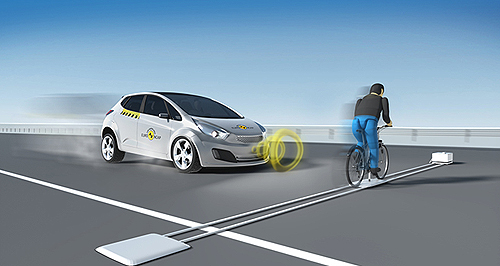News - General News - SafetyCyclists a headache for anti-crash techSteer clear: Vehicle crash avoidance standards for cars and pedestrians are in sight, but cyclists might be a different matter. Global experts struggle to arrive at AEB standards for bicycle crash avoidance13 Sep 2018 CYCLISTS are proving problematic for international vehicle safety authorities working on new United Nations regulations governing anti-collision autonomous emergency braking (AEB) systems scheduled to come into force from 2020.
The experts are in a quandary on whether it is better for a vehicle to swerve or simply brake automatically to avoid a collision with a cyclist.
The rules, which filter down to countries such as Australia under the World Forum for Harmonisation of Vehicle Regulations, are seen as critical in the brave new world of autonomous vehicles.
A draft proposal submitted to the UN Economic Commission for Europe’s working party on autonomous and connected vehicles by an informal group of international experts suggests that cars must be able to avoid a nose-to-tail collision with a stationary vehicle at up to 42km/h in urban driving conditions, or up to 30km/h on a wet road.
After that, the vehicle must mitigate the collision impact by up to 25km/h from 60km/h.
The proposed rules also stipulate that these AEB-equipped cars travelling at up to 30km/h must be able to detect and automatically brake to avoid hitting a pedestrian on the street walking at up to 5km/h.
Again, above 30km/h the vehicle must be able to mitigate the impact. The document suggests that requirement be stiffened to 42km/h from 2023 as technology improves.
But notes attached to the draft proposals reveal that the experts are having trouble arriving at regulations for car-to-bicycle AEB crash avoidance due to a lack of test data from vehicles fitted with suitable technology.
One of the problems is that some of the experts believe that avoiding a from-behind collision with a cyclist riding in the same direction as a vehicle – one of the two most common bike crash scenarios – would be better served by a steering correction than mere braking.
“The usefulness of such a braking test needs to be checked again,” the group states.
It seems that if the group cannot agree on the most effective way of tackling the bike problem by the time the draft rules are due to go before the formal working party on autonomous vehicles in February, it might be put into the too-hard basket for stage one of the regulations, leaving it to be addressed later.
The group, which includes Australian representation, is scheduled to meet again on October to refine the proposed regulations ahead of the February meeting.
Before that, the working party on autonomous vehicles and connected vehicles will meet in Geneva to discuss, among a wide range of subjects, a submission from a German expert to amend existing AEB regulations governing highway travel.
The amendments call for vehicles to avoid collisions with stationary or constant moving targets at up to 70km/h on dry roads and 40km/h on wet roads.
AEB will be mandatory above 30km/h, even on vehicles in which it is possible to turn off the safety device, and must operate to the maximum speed of the vehicle.
Manufacturers will be required to test the device at speeds of between 20 and 100km/h.
In other draft regulations for discussion, remote control manoeuvring of vehicles – as demonstrated by BMW – will come under formal control.
This function involves car drivers using a device – commonly a phone app – to direct their vehicle into a garage or similar from outside the car.
Under the draft rules, the vehicles must not travel at more than 5km/h and nor will they be permitted to travel more than 100 metres.
The “driver” must be in control at all times, and the vehicle must be able to detect obstacles and stop automatically, as well as automatically brake to prevent roll-away when parked.  |
Click to shareGeneral News articlesResearch General News Motor industry news |














Facebook Twitter Instagram